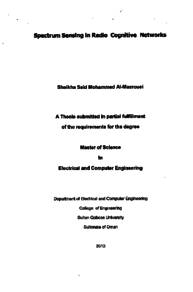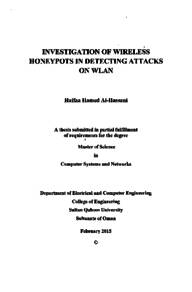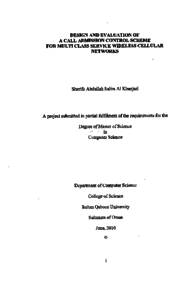Document
Spectrum sensing in radio cognitive networks.
Publisher
Sultan Qaboos University
Gregorian
2013
Language
English
English abstract
Over the last two decades, huge efforts have been devoted to developing efficient wireless communication technologies that can deal with the ever growing user demands. One of the most critical challenges related to the growth of wireless networks is the usage and management of the electromagnetic radio spectrum as this is the most precious and limited resource. For this reason, cognitive radio (CR) systems which can support dynamic access to the available spectrum has been suggested as the key enabling technology to increase spectrum utilization to face the huge expansion of wireless systems. Cognitive network (CN) consists of elements, which through learning and reasoning, dynamically adapt to varying network conditions in order to optimize end-to-end performance. The Network can learn from these adaptations and use them to make future decisions. This thesis aims to clearly investigate and study the MAC layer sensing schemes in Cognitive Radio Networks. Two sensing approaches, reactive and proactive, are examined and compared via two performance metrics, achieved spectrum utilization factor and idle channel search delay. Matlab simulations were carried out and the results show that the proactive sensing in uncongested radio environments is better to be used as it is idle channel search delay is much less than reactive sensing. With the increase of congestion in the radio environment, using of reactive sensing becomes more desirable to decrease idle channel search delay.
Member of
Resource URL
Arabic abstract
على امتداد العقدين الأخيرين بذلت جهود ضخمة لتطوير كفاءة تقنيات الإتصالات اللاسلكية التي يمكن أن تتعامل مع طلبات المستخدمين المتزايدة. وإن من أهم التحديات المرتبطة بنمو الشبكات اللاسلكية هي استخدام وإدارة الطيف الترددي الكهرومغناطيسي باعتبارهمن أثمن الموارد المحدودة. لهذا السبب فان نظام الراديو الإدراكي (Cognitive Radio) الذي يمكن أن يدعم الوصول إلى دينامية الطيف المتاح قد اقترح ليكون الحل الرئيسي لزيادة الاستخدام الامثاللطيف الترددي لمواجهة التوسع الهائل في الأنظمة اللاسلكية إن شبكة الراديو الإدراكية (Cognitive Radio Network ) تتكون منعناصر التي من خلال التعلم والتفكير، والتكيف مع أوضاع الشبكات المتغيرة بهدف الإستفادة المثلى للأداء المتواصل. ويمكن لهذا النوع من الشبكاتان تتعلم من هذه التعديلات وتستخدمها لإتخاذ قرارات في المستقبل. هذه الرسالة تهدف إلى استكشاف ودراسة الإستشعار في طبقةMACفي شبكة الراديوالإدراكية. في هذه الدراسة يتم فحص نهجين للإستشعار في هذه الطبقة وهمارد الفعل والمبادرة( reactive and proactive) عبر مقارنة إثنين من مقاييس الأداء وهما: معامل الإستخدامالطيف الترددي المحقق (achieved spectrum utilization factor) وتأخير البحث عن القناة الفارغة(idie channel search delay).
وأجريت عمليات محاكاة باستخدام برنامج ماتلاب وتوضح النتائج أن الإستشعار عن طريق المبادرة(proactive) في بيئة الراديو المزدحمة هو الأفضل للاستخدام وذلك لأن تأخير البحث عن القناة الفارغة هو الأقل من النوع الثاني للإستشعار. ومع زيادة الإزدحام في البيئة الراديوية يبدو أن الإستشعار عن طريق ردة الفعل (reactive) هو الأفضل.
وأجريت عمليات محاكاة باستخدام برنامج ماتلاب وتوضح النتائج أن الإستشعار عن طريق المبادرة(proactive) في بيئة الراديو المزدحمة هو الأفضل للاستخدام وذلك لأن تأخير البحث عن القناة الفارغة هو الأقل من النوع الثاني للإستشعار. ومع زيادة الإزدحام في البيئة الراديوية يبدو أن الإستشعار عن طريق ردة الفعل (reactive) هو الأفضل.
Category
Theses and Dissertations




